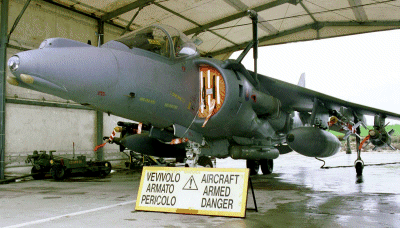Tim Ripley & Stewart Penney/LONDON
Only 40% of the bombs dropped by the Royal Air Force during last year's Kosovo conflict have been confirmed as hitting their targets, according to a UK Ministry of Defence operational analysis.

The data, seen exclusively by Flight International, paints a bleak picture of weapon system and bomb-aiming software performance.
The results of the study by MoD's scrutiny and analysis branch draws on data collected last year by a team from the Defence Evaluation and Research Agency.
The results appear to indicate a low point in the RAF's laser-guided bombing performance. During the 1991 Gulf War the TIALD designator pod manufacturer (then GECFerranti) claimed a 100%success rate for the TIALD/Paveway II combination.
But a senior defence source says this was due to good weather, flat terrain and easily identifiable targets such as airfields and ammunition dumps. In the case of Kosovo, he says, the need to maintain a high operational tempo, operate in poor weather and in difficult terrain meant the figures are not as good as for some previous operations, including Deliberate Force over Bosnia in 1995, which had an 85% success rate.
During the 78-day Kosovo campaign, BAE Systems Harrier GR7 and Panavia Tornado GR1 strike missions achieved 65% hit rates with 454kg (1,000lb) Raytheon Paveway II laser guided bombs (LGBs) in combination with BAE's TIALD, the report states.
The defence official says that, while a valuable "scientific analysis", the work "does not take into account operational factors". In 1995 the 12-day Bosnia action was "coercive" with easily identified targets and missions taking place only in good weather, he says.
UK experience with the 905kg (2,000lb) Paveway III bomb was mixed, with the Tornado force hitting 53% of its targets. The Harrier had no success with the weapon, says the source, due to an integration problem which has now been rectified.
Performance of high-altitude-delivered unguided weapons was also poor. Only 40% of the Hunting RBL755 cluster bombs hit their targets, the report says. Some 31% of the cluster bombs missed their targets, while 29% cannot be accounted for.
The weakest results were attributed to 454kg (1,000lb) unguided bombs with impact fuzes, with only 2% being confirmed as hitting their targets and 89% unaccounted for. Air burst-fuzed bombs were better, with 30% being on target, 35% missing and the outcome of the remainder unknown.
The source says that weather was a major factor over Kosovo, forcing the RAF to find ways of dropping bombs when targets were obscured. Explaining the difficulty in accounting for "hits" and "misses", he adds that all unguided drops were through cloud, and the few recorded successes were when the assessment aircraft flying with the strike package was able to see through breaks in the overcast.
Assessments could not be made on the ground after the conflict because the targets had been "visited" many times and it is impossible to distinguish between the various craters, he says. To avoid collateral damage, GPS-aided release of unguided bombs was only used on large area targets, he adds.
The study concludes that 60 fixed targets were badly damaged or destroyed by the RAF and 75 tactical targets hit by 1,008 RAF attack sorties.
According to the study, 47% of the planned strike missions were aborted, with 35% of these failures attributed to bad weather. The next biggest factor for aborting missions was "no valid target". This is because the majority of the Harrier sorties were close air support, where the aircraft would wait for information from a forward air controller (FAC). If no targets - typically tanks, artillery and troop concentrations - were found by the FAC, the Harriers returned to base with their weapons on-board.
Some serving aircrew attribute the RAF's performance to a lack of training due to spending cuts - many Harrier crews had not dropped LGBs before the 1999 conflict - and continuing problems integrating the latest TIALD pod on to the Harrier and Tornado - particularly high latency rates for guidance data transfer.
Lessons from the report have led to a UK acquisition of Raytheon AGM-65G Maverick missiles to replace the RBL755 and a commitment to give the LGBs embedded satellite navigation to give an all-weather capability.
Source: Flight International























